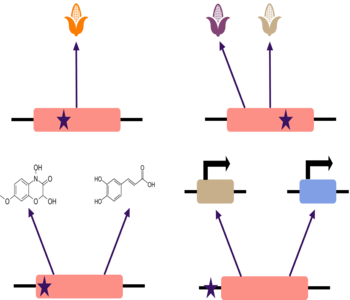Elucidating the patterns of pleiotropy and its biological relevance in maize

Short Summary:
- Pleiotropy is not common in maize
- Pleiotropy in crop plants is highly constrained by evolution
- Pleiotropy results may vary by population and trait type
Abstract
Pleiotropy - when a single gene controls two or more seemingly unrelated traits - has been shown to impact genes with effects on flowering time, leaf architecture, and inflorescence morphology in maize. However, the genome-wide impact of true biological pleiotropy across all maize phenotypes is largely unknown. Here we investigate the extent to which biological pleiotropy impacts phenotypes within maize through GWAS summary statistics reanalyzed from previously published metabolite, field, and expression phenotypes across the Nested Association Mapping population and Goodman Association Panel. Through phenotypic saturation of 120,597 traits, we obtain over 480 million significant quantitative trait nucleotides. We estimate that only 1.56-32.3% of intervals show some degree of pleiotropy. We then assessed the relationship between pleiotropy and various biological features such as gene expression, chromatin accessibility, sequence conservation, and enrichment for gene ontology terms. We find very little relationship between pleiotropy and these variables when compared to permuted pleiotropy. We hypothesize that biological pleiotropy of common alleles is not widespread in maize and is highly impacted by nuisance terms such as population structure and linkage disequilibrium. Natural selection on large standing natural variation in maize populations may target wide- and large-effect variants, leaving the prevalence of detectable pleiotropy relatively low.
This paper has been accepted to PLOS Genetics (doi TBD)